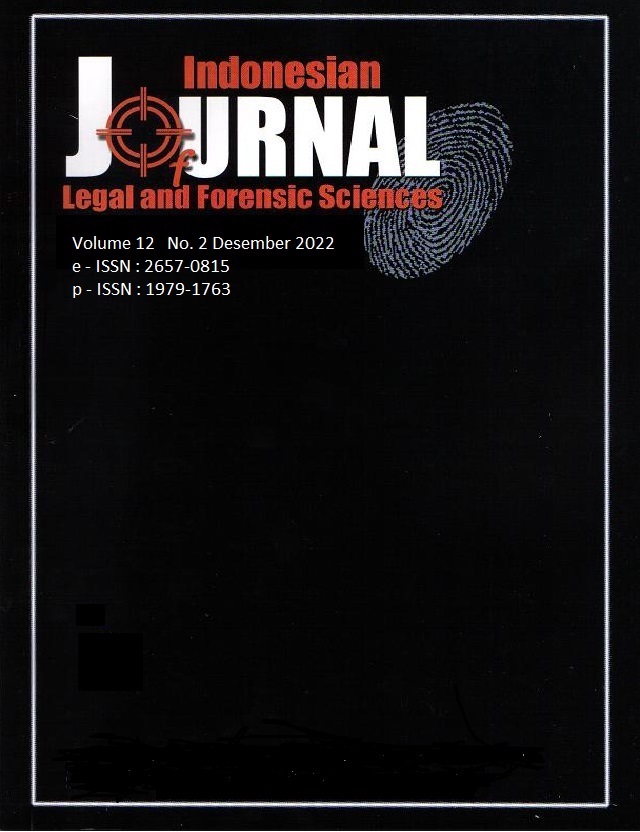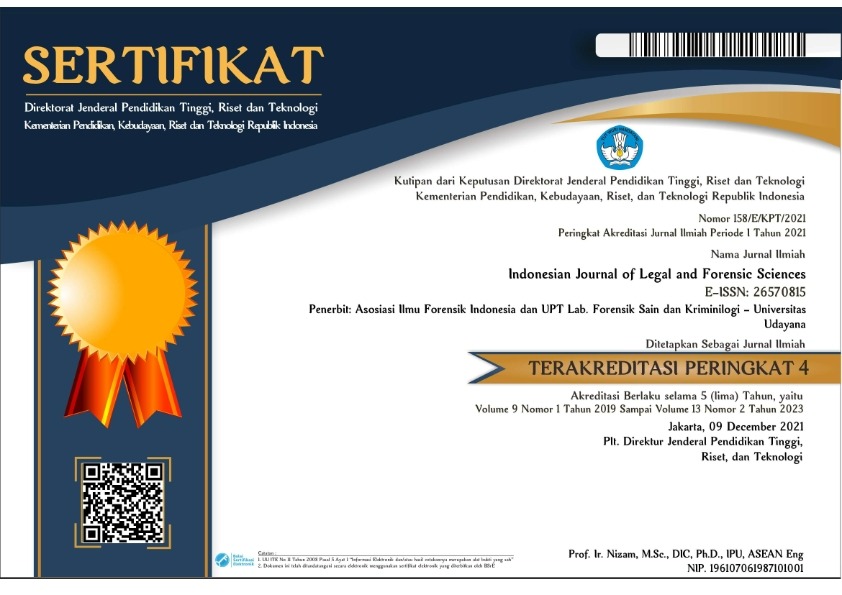Budaya Modifikasi Gigi dalam Konteks Antropologi Forensik di Indonesia
Abstract
In a forensic anthropology context, the human identification process requires two equally important aspects—biological and sociocultural. Unfortunately, the latter is often overlooked. Albeit, culture can leave important markers on the human body. Thus, it may aid forensic anthropologists to identify the demographic and cultural characteristics of an unknown individual. This review article’s purpose is to discuss varieties of cultural dental modification in Indonesia and its significance in forensic identification. This paper reviewed at least 15 primary works of literature acquired from Google Scholar, while a handful of other literature is additional. Then, the data from said literature was extracted into four subchapters. Consumption of betel nut can influence various dental characteristics, such as dental staining and calculus. This paper also discusses dental sharpening and inlay. Dental ablation is a relatively ancient culture that symbolizes mourn or marriage and is often misidentified as other types of AMTL. Daily activities, e.g., diet and tooth brushing habits also influence human dentition. Based on the literature review, the author concluded that various types of dental modification are performed by many cultures across Indonesia, with one culture bearing unique features that differentiate them from other cultures. During the identification process, it is important to know what type of modification is performed, whose dentitions are modified, and which teeth are modified—since it may bare significance to the individualization process.
Downloads
References
[2] Suriyanto RA, Koesbardiati T. Dental modifications: a perspective of Indonesian chronology and the current applications. Dent J (Majalah Kedokt Gigi) 2010;43:81. https://doi.org/10.20473/j.djmkg.v43.i2.p81-90.
[3] Taylor KT. Forensic Art and Illustration. 1st ed. Boca Raton: CRC Press; 2000.
[4] Fachruliansyah I. Antropologi Biologi di Indonesia: Sebuah Penelusuran dan Kemungkinan Pengembangan. Antropol Indones 2018;39:90–114. https://doi.org/10.7454/ai.v39i2.11128.
[5] Koesbardiati T, Murti DB, Putri RS. Petunjuk Identifikasi Rangka Manusia. Surabaya: Direktorat Cagar Budaya dan Museum, Kementerian Pendidikan dan Kebudayaan Republik Indonesia; 2017.
[6] Artaria MD. Antropologi Dental. 1st ed. Yogyakarta: Graha Ilmu; 2009.
[7] Permatasari WA, Artaria MD. Keterkaitan kebiasaan manusia terhadap kondisi gigi. Masyarakat, Kebud Dan Polit 2015;28:181–7. https://doi.org/10.20473/mkp.V28I42015.181-187.
[8] Koesbardiati T. Social identity: an interpretation of dental modification practices on Indonesian historical human remains. Bull Int Assoc Paleodont 2016;10:60–5.
[9] Koesbardiati T, Bayu Murti D. Konsumsi Sirih Pinang Dan Patologi Gigi Pada Masyarakat Prasejarah Lewoleba Dan Liang Bua, Di Nusa Tenggara Timur, Indonesia. Berk Arkeol 2019;39:121–38. https://doi.org/10.30883/jba.v39i2.470.
[10] Lustiawati A. Tradisi Nginang. Kaji Ilmu Sos 2019. https://kjnsosial.blogspot.com/2019/12/tradisi-nginang.html (accessed September 20, 2022).
[11] Scott GR. Dental Anthropology. Encycl. Glob. Archaeol., Cham: Springer International Publishing; 2018, p. 1–8. https://doi.org/10.1007/978-3-319-51726-1_138-2.
[12] Scott GR, Turner II CG. Dental Anthropology. Annu Rev Anthropol 1988;17:99–126.
[13] Unbanu DK, Obi AL, Fankari F, Nubatonis MO. Status Kesehatan Gigi Dan Mulut Pada Masyarakat Yang Mempunyai Kebiasaan Menginang. Dent Ther J 2019;1:52–7. https://doi.org/10.31965/dtj.v1i2.447.
[14] Sutana IG, Sari NMS, Dwipayana AAP. Nginang : Kebiasaan Masyarakat Tradisional dalam Memelihara Kesehatan Gigi dan Mulut. J Yoga Dan Kesehat 2021;4:123–35.
[15] Ritonga SW, Nurhamidah, Lestari C. Pengaruh budaya makan sirih terhadap penyakit periodontal pada masyarakat di Desa Tanjung Medan Kecamatan Bilah Barat Labuhan Batu. B-Dent, J Kedokt Gigi Univ Baiturrahmah 2019;4:45–51. https://doi.org/10.33854/jbdjbd.88.
[16] Parianti NKW, Ariyasa IG. Hubungan Kebiasaan Menyirih Terhadap Kejadian Karies Gigi Pada Lanjut Usia Di Desa Batubulan Kangin. J Virgin, Jilid 2015;1:2442–509.
[17] Iptika A. Keterkaitan kebiasaan dan kepercayaan mengunyah sirih Pinang dengan kesehatan gigi. Masyarakat, Kebud Dan Polit 2014;3:64–9.
[18] Anand R, Dhingra C, Prasad S, Menon I. Betel nut chewing and its deleterious effects on oral cavity. J Cancer Res Ther 2014;10:499–505. https://doi.org/10.4103/0973-1482.137958.
[19] Norton SA. Betel: Consumption and consequences. J Am Acad Dermatol 1998;38:81–8. https://doi.org/https://doi.org/10.1016/S0190-9622(98)70543-2.
[20] Lin Y-S, Jen Y-M, Wang B-B, Lee J-C, Kang B-H. Epidemiology of oral cavity cancer in Taiwan with emphasis on the role of betel nut chewing. ORL J Oto-Rhino-Laryngology, Head Neck Surg 2005;67:230–6. https://doi.org/10.1159/000089214.
[21] Hernandez BY, Zhu X, Goodman MT, Gatewood R, Mendiola P, Quinata K, et al. Betel nut chewing, oral premalignant lesions, and the oral microbiome. PLoS One 2017;12:1–19. https://doi.org/10.1371/journal.pone.0172196.
[22] World Health Organization. Review of Areca (Betel) Nut and Tobacco Use in the Pacific: A Technical Report. Manila: 2012.
[23] Touwely S, Kakiay AC, Makulua K. Sirih pinang sebagai simbol pemersatu keluarga (suatu kajian pemaknaan budaya sirih pinang dalam konteks masyarakat Riring, Kecamatan Taniwel). NOUMENA J Ilmu Sos Keagamaan 2020;I:12–27.
[24] Ngadilah C, Pinat LM. Memprediksi Kebiasaan Mengkonsumsi Sirih Pinang Dan Pengaruhnya Terhadap Kerusakan Jaringan Periodontal. Pros. Semnas I Kesehat. Lingkung. Penyakit Trop., Kota Kupang: Prodi Sanitasi, Poltekkes Kemenkes Kupang; 2019, p. 16–26.
[25] Murti DB, Koesbardiati T. Mandibular anterior tooth wear of individuals from Liang Bua, Lewoleba, and Melolo: An indication of cultural activity related patterns. Bull Int Assoc Paleodont 2019;13:23–30.
[26] Kinaston RL, Koesbardiati T, Suriyanto RA, Buckley HR, Halcrow SE, Foster A, et al. Ritual tooth ablation and the Austronesian expansion: Evidence from eastern Indonesia and the Pacific Islands. J Isl Coast Archaeol 2022;17:65–96. https://doi.org/10.1080/15564894.2020.1754971.
[27] Koesbardiati T, Murti DB, Suriyanto RA. Cultural Dental Modification in Prehistoric Population in Indonesia. Bull Int Assoc Paleodont 2015;9:52–60.
[28] Suhendra N, Adhinugroho B, Abdillah YB, Wisnuyana B, Maulana AA, Mahardika BM, et al. Positive Identification on the Skull From Colonial Era in Balai Pemuda, Surabaya. Kapata Arkeol 2022;17:33–42. https://doi.org/10.24832/kapata.v17i1.33-42.
[29] Abdillah YB, Wisnuyana B, Maulana B, Mahardika, Adhinugroho SB, Firdaus T, et al. Dental modification on the skull found during basement construction at Balai Pemuda building, Indonesia. Bull Int Assoc Paleodont 2018;12:47–53.
[30] Koesbardiati T, Suriyanto RA. Menelurusi Jejak Populasi Morfologi Pangur Gigi-Geligi: Kajian Pendahuluan Atas Sampel Gigi Geligi Dari Beberapa Situs Purbakala Di Jawa, Bali, dan Nusa Tenggara Timur. Humaniora 2007;19:33–42. https://doi.org/10.22146/jh.889.
[31] Suriyanto RA, Koesbardiati T, Murti DB. The Dental Modifications in Ancient Until Present Indonesia a Chronological Evidence of Indonesian Racial Identity. J Penelit Arkeol Papua Dan Papua Barat 2011;3:1–41. https://doi.org/10.24832/papua.v3i2.81.
[32] Prayudi A, Adi Suriyanto R. Studi Patologi dan Kultural pada 19 Gigi Lepas dari Kotak TP Geo IV Situs Gunungwingko. Berk Arkeol 2019;39:1–16. https://doi.org/10.30883/jba.v39i1.337.
[33] Rumbiati AR, Putra YY. Konsep Diri pada Masyarakat Mentawai yang Memakai Tato. J RAP UNP 2015;6:114–25. https://doi.org/10.24036/rapun.v6i2.6614.
[34] Munandar A, Noer M, Erwin E, Syahni R. Keragaman Bentuk Kearifan Lokal Masyarakat Suku Mentawai di Kawasan Wisata Bahari Pulau Siberut. Menara Ilmu 2022;16:1–10. https://doi.org/10.31869/mi.v16i1.3243.
[35] Prayudi A, Suriyanto RA, Rahmawati NT. Teeth of royalty from a burial in Jera Lompo’e, South Sulawesi, Indonesia. Bull Int Assoc Paleodont 2018;12:23–8.
[36] Mower JP. Deliberate ante-mortem dental modification and its implications in archaeology, ethnography and anthropology. Pap from Inst Archaeol 1999;10:37–53. https://doi.org/10.5334/pia.137.
[37] Budisuari MA, Oktarina, Mikrajab MA. Hubungan Pola Makan dan Kebiasaan Menyikat Gigi dengan Kesehatan Gigi dan Mulut (Karies) di Indonesia. Bul Penelit Sist Kesehat 2010;13:83–91.
[38] Wahjuningsih E, Aprilia. Diamond, Modifikasi Gigi Masa Kini. In: Karmaya NM, Sugiritama IW, Widianti IGA, Wahyuniari IAI, Wardana ING, Arijana IGKN, et al., editors. Proceeding B. Pertem. Ilm. Nas. Perhimpun. Ahli Anat. Indones. 2012, Denpasar: Udayana University Press; 2012, p. 454–62.
[39] Waters-Rist A. Book Review: A World View of Bioculturally Modified Teeth. Dent Anthropol J 2021;34:55–6. https://doi.org/10.26575/daj.v34i1.327.
[40] KBBI Daring. gigi. KBBI Daring 2021. https://kbbi.web.id/gigi (accessed October 14, 2021).
[41] Hillson S. Dental Anthropology. 1st ed. Cambridge: Cambridge University Press; 1996. https://doi.org/10.1017/CBO9781139170697.
[42] Badruddin IA, Kiptiyah NM, Prihartono N, Agtini MD, Musadad DA. The Association between Sweet Food Consumption, Time of Tooth Brushing and Dental Caries Experience in 12- to 15-Year-old Children in Indonesia (Analysis of Indonesian Health Basic Research Data, 2013). J Int Dent Med Res 2017;10:583–9.
[43] Budijanto D, Kurniawan R, Widiantini W, Sakti ES, Mulya D. InfoDATIN Kesehatan Gigi Nasional September 2019. Jakarta: 2019.



















